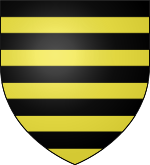House of Ascania
| House of Ascania | |
|---|---|
 
|
|
| Country | Germany, Russia, Ukraine, Estonia, Latvia, Belarus, Kazakhstan, Lithuania |
| Titles | |
| Founded | 1036 |
| Founder | Esiko, Count of Ballenstedt |
| Final ruler | Joachim Ernst, Duke of Anhalt |
| Current head | Eduard, Prince of Anhalt |
| Deposition | 1918 (Duchy of Anhalt) |
The House of Ascania (German: Askanier) is a dynasty of German rulers. It is also known as the House of Anhalt, after Anhalt, its longest-held possession.
The Ascanians are named after Ascania (or Ascaria) Castle, Schloss Askanien, which is located near and named after Aschersleben. The castle was seat of the County of Ascania, a title that was later subsumed into the titles of the princes of Anhalt.
The earliest known member of the house, Esiko, Count of Ballenstedt, first appears in a document of 1036, and is assumed to have been a grandson (through his mother) of Odo I, Margrave of the Saxon Ostmark. From Odo, the Ascanians inherited large properties in the Saxon Eastern March.
Esiko's grandson was Otto, Count of Ballenstedt, who died in 1123. By Otto's marriage to Eilika, daughter of Magnus, Duke of Saxony, the Ascanians became heirs to half of the property of the House of Billung, former dukes of Saxony.
Otto's son, Albert the Bear, became, with the help of his mother's inheritance, the first Ascanian duke of Saxony in 1139. But he lost control of Saxony soon to the rival House of Guelph.
However, Albert inherited the Margraviate of Brandenburg from its last Wendish ruler, Pribislav, in 1157, and became the first Ascanian margrave. Albert, and his descendants of the House of Ascania, then made considerable progress in Christianizing and Germanizing the lands. As a borderland between German and Slavic cultures, the country was known as a march.
...
Wikipedia
